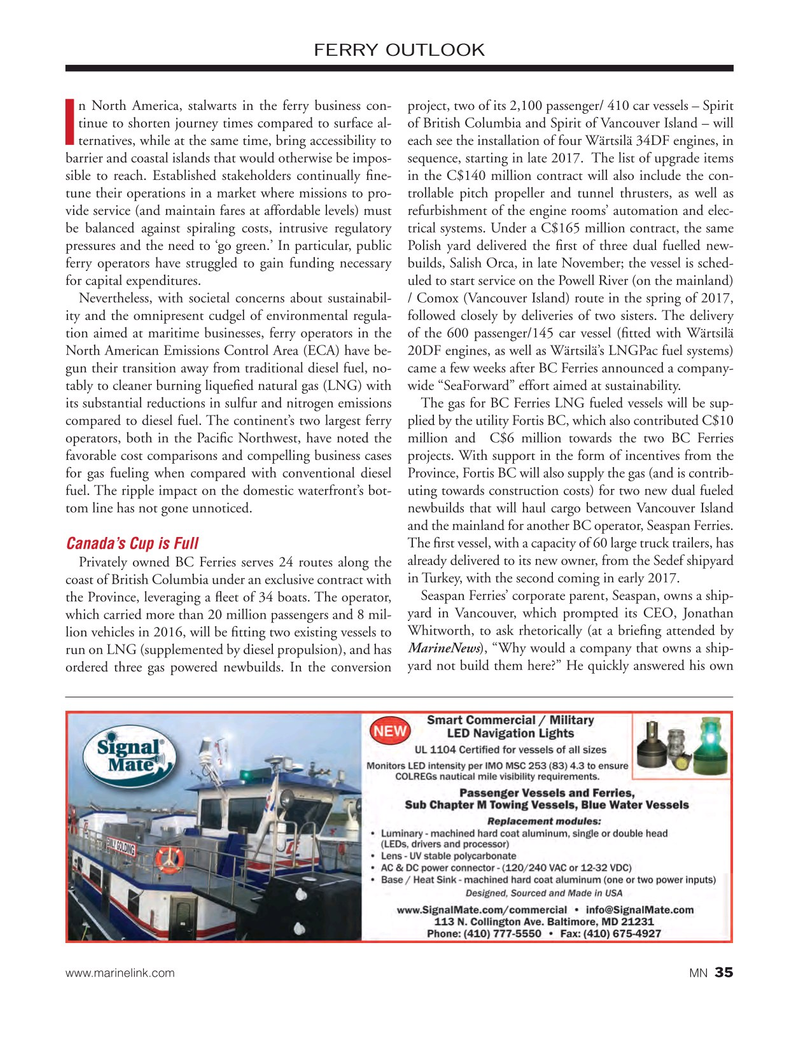
Page 35: of Marine News Magazine (January 2017)
Passenger Vessels & Ferries
Read this page in Pdf, Flash or Html5 edition of January 2017 Marine News Magazine
FERRY OUTLOOK n North America, stalwarts in the ferry business con- project, two of its 2,100 passenger/ 410 car vessels – Spirit tinue to shorten journey times compared to surface al- of British Columbia and Spirit of Vancouver Island – will
I ternatives, while at the same time, bring accessibility to each see the installation of four Wärtsilä 34DF engines, in barrier and coastal islands that would otherwise be impos- sequence, starting in late 2017. The list of upgrade items sible to reach. Established stakeholders continually ? ne- in the C$140 million contract will also include the con- tune their operations in a market where missions to pro- trollable pitch propeller and tunnel thrusters, as well as vide service (and maintain fares at affordable levels) must refurbishment of the engine rooms’ automation and elec- be balanced against spiraling costs, intrusive regulatory trical systems. Under a C$165 million contract, the same pressures and the need to ‘go green.’ In particular, public Polish yard delivered the ? rst of three dual fuelled new- ferry operators have struggled to gain funding necessary builds, Salish Orca, in late November; the vessel is sched- for capital expenditures. uled to start service on the Powell River (on the mainland)
Nevertheless, with societal concerns about sustainabil- / Comox (Vancouver Island) route in the spring of 2017, ity and the omnipresent cudgel of environmental regula- followed closely by deliveries of two sisters. The delivery tion aimed at maritime businesses, ferry operators in the of the 600 passenger/145 car vessel (? tted with Wärtsilä
North American Emissions Control Area (ECA) have be- 20DF engines, as well as Wärtsilä’s LNGPac fuel systems) gun their transition away from traditional diesel fuel, no- came a few weeks after BC Ferries announced a company- tably to cleaner burning lique? ed natural gas (LNG) with wide “SeaForward” effort aimed at sustainability. its substantial reductions in sulfur and nitrogen emissions The gas for BC Ferries LNG fueled vessels will be sup- compared to diesel fuel. The continent’s two largest ferry plied by the utility Fortis BC, which also contributed C$10 operators, both in the Paci? c Northwest, have noted the million and C$6 million towards the two BC Ferries favorable cost comparisons and compelling business cases projects. With support in the form of incentives from the for gas fueling when compared with conventional diesel Province, Fortis BC will also supply the gas (and is contrib- fuel. The ripple impact on the domestic waterfront’s bot- uting towards construction costs) for two new dual fueled tom line has not gone unnoticed. newbuilds that will haul cargo between Vancouver Island and the mainland for another BC operator, Seaspan Ferries.
The ? rst vessel, with a capacity of 60 large truck trailers, has
Canada’s Cup is Full
Privately owned BC Ferries serves 24 routes along the already delivered to its new owner, from the Sedef shipyard coast of British Columbia under an exclusive contract with in Turkey, with the second coming in early 2017.
Seaspan Ferries’ corporate parent, Seaspan, owns a ship- the Province, leveraging a ? eet of 34 boats. The operator, yard in Vancouver, which prompted its CEO, Jonathan which carried more than 20 million passengers and 8 mil- lion vehicles in 2016, will be ? tting two existing vessels to Whitworth, to ask rhetorically (at a brie? ng attended by run on LNG (supplemented by diesel propulsion), and has MarineNews), “Why would a company that owns a ship- ordered three gas powered newbuilds. In the conversion yard not build them here?” He quickly answered his own www.marinelink.com MN 35
MN Jan17 Layout 32-49.indd 35 MN Jan17 Layout 32-49.indd 35 1/5/2017 4:53:24 PM1/5/2017 4:53:24 PM

 34
34

 36
36
